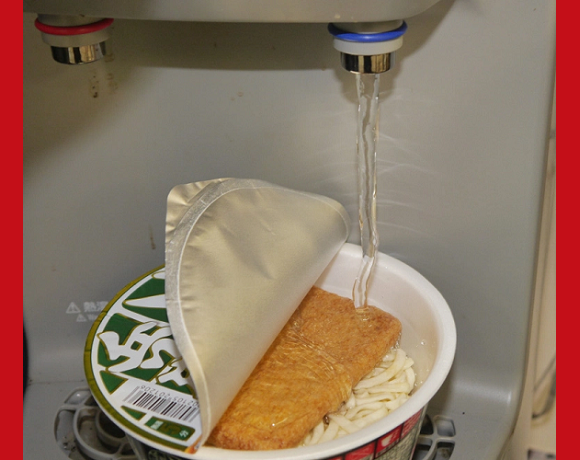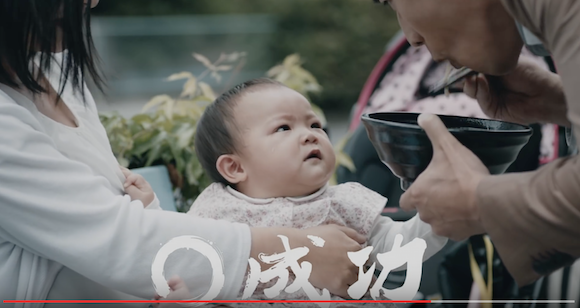udon (Page 5)
These plastic warriors are trawling for a brawling, cruising for a bruising, and sampling for a trampling.
Our Japanese reporter investigates the Michelin-recommended udon restaurant and nabs one of their precious thirty meals per day.
Read More
Normally feel a bit peckish during an ultra-marathon? Then stop for some udon noodles, six times!
Our taste-tester Meg finds out if sushi soup is a guilty pleasure, or an unforgivable sin.
Prepaid tempura plan is totally the way to go, and even lets you choose fried chicken if that’s what your heart desires.
As if there weren’t enough crazy sweet flavors to satiate our rumbling stomachs!
Read More
I can say fairly certainly that this is the greatest painting of instant deep-fried vegetables ever made.
These crying babies are immediately calmed by the sound of slurping, which is said to sound similar to noises heard in the womb.
Osaka kitty’s adorable quest to gain entrance to noodle restaurant caught on video.
Finally, a way to eat these delicious spongy white noodles on the go. You don’ wanna miss it!
Sometimes there are restaurants you want to keep a secret all to yourself, and this is definitely one of them.



















 Mr. Sato accosts award-winning actor Hideaki Ito【Interview】
Mr. Sato accosts award-winning actor Hideaki Ito【Interview】 7-Eleven Japan starts new temporary luggage storage service in over 300 branches
7-Eleven Japan starts new temporary luggage storage service in over 300 branches 7-Eleven Japan’s ramen-cooking robot whipped us up a bowl of noodles【Taste test】
7-Eleven Japan’s ramen-cooking robot whipped us up a bowl of noodles【Taste test】 More Than a Capsule Stay: Why Solo Travelers Choose “global cabin Yokohama Chinatown”
More Than a Capsule Stay: Why Solo Travelers Choose “global cabin Yokohama Chinatown” Sushi passed up by ramen in survey of foreign tourists’ favorite thing to eat in Japan, but why?
Sushi passed up by ramen in survey of foreign tourists’ favorite thing to eat in Japan, but why? National Geographic names Yamagata Prefecture on its “Best of the World 2026” travel destinations
National Geographic names Yamagata Prefecture on its “Best of the World 2026” travel destinations Japan’s plus-sized idol singer group releases new video about the joys of eating【Video】
Japan’s plus-sized idol singer group releases new video about the joys of eating【Video】 Japan’s otoshidama tradition of giving kids money at New Year’s gets a social welfare upgrade
Japan’s otoshidama tradition of giving kids money at New Year’s gets a social welfare upgrade How to find a lost cat: Unique method from Japan proves to be surprisingly effective
How to find a lost cat: Unique method from Japan proves to be surprisingly effective Mega huge Mega Charizard Pokémon kites fly in the skies of Japan【Video】
Mega huge Mega Charizard Pokémon kites fly in the skies of Japan【Video】 Disillusionment at Tsukiji’s tourist-target prices led us to a great ramen restaurant in Tokyo
Disillusionment at Tsukiji’s tourist-target prices led us to a great ramen restaurant in Tokyo Japan may add Japanese language proficiency, lifestyle classes to permanent foreign resident requirements
Japan may add Japanese language proficiency, lifestyle classes to permanent foreign resident requirements Starbucks Japan releases new zodiac chilled cup drink for 2026
Starbucks Japan releases new zodiac chilled cup drink for 2026 Lacquerware supplier to emperor of Japan and Pokémon team up for new tableware
Lacquerware supplier to emperor of Japan and Pokémon team up for new tableware Starbucks teams up with 166-year-old Kyoto doll maker for Year of the Horse decorations【Photos】
Starbucks teams up with 166-year-old Kyoto doll maker for Year of the Horse decorations【Photos】 Starbucks on a Shinkansen bullet train platform: 6 tips for using the automated store in Japan
Starbucks on a Shinkansen bullet train platform: 6 tips for using the automated store in Japan Is this the most relaxing Starbucks in Japan?
Is this the most relaxing Starbucks in Japan? Large amount of supposed human organs left in Osaka marketplace
Large amount of supposed human organs left in Osaka marketplace Tokyo’s Tsukiji sushi neighborhood asks tour groups to stay away for the rest of the month
Tokyo’s Tsukiji sushi neighborhood asks tour groups to stay away for the rest of the month Japan’s human washing machines will go on sale to general public, demos to be held in Tokyo
Japan’s human washing machines will go on sale to general public, demos to be held in Tokyo Japanese train company is letting fans buy its actual ticket gates for their homes
Japanese train company is letting fans buy its actual ticket gates for their homes Tokyo considering law requiring more trash cans following litter increase in heavily touristed area
Tokyo considering law requiring more trash cans following litter increase in heavily touristed area Nintendo’s Kirby now delivering orders at Kura Sushi restaurants, but not in Japan
Nintendo’s Kirby now delivering orders at Kura Sushi restaurants, but not in Japan Tokyo event lets you travel back in time, for free, to celebrate 100 years since Showa era start
Tokyo event lets you travel back in time, for free, to celebrate 100 years since Showa era start Sanrio theme park in Japan announces plans to expand into a Sanrio resort
Sanrio theme park in Japan announces plans to expand into a Sanrio resort Survey asks foreign tourists what bothered them in Japan, more than half gave same answer
Survey asks foreign tourists what bothered them in Japan, more than half gave same answer Japan’s deadliest food claims more victims, but why do people keep eating it for New Year’s?
Japan’s deadliest food claims more victims, but why do people keep eating it for New Year’s? We deeply regret going into this tunnel on our walk in the mountains of Japan
We deeply regret going into this tunnel on our walk in the mountains of Japan Studio Ghibli releases Kodama forest spirits from Princess Mononoke to light up your home
Studio Ghibli releases Kodama forest spirits from Princess Mononoke to light up your home Major Japanese hotel chain says reservations via overseas booking sites may not be valid
Major Japanese hotel chain says reservations via overseas booking sites may not be valid Put sesame oil in your coffee? Japanese maker says it’s the best way to start your day【Taste test】
Put sesame oil in your coffee? Japanese maker says it’s the best way to start your day【Taste test】 The top 10 annoying foreign tourist behaviors on trains, as chosen by Japanese people【Survey】
The top 10 annoying foreign tourist behaviors on trains, as chosen by Japanese people【Survey】 No more using real katana for tourism activities, Japan’s National Police Agency says
No more using real katana for tourism activities, Japan’s National Police Agency says Starbucks Japan reveals new sakura drinkware collection, inspired by evening cherry blossoms
Starbucks Japan reveals new sakura drinkware collection, inspired by evening cherry blossoms National Geographic names Yamagata Prefecture on its “Best of the World 2026” travel destinations
National Geographic names Yamagata Prefecture on its “Best of the World 2026” travel destinations Japan’s plus-sized idol singer group releases new video about the joys of eating【Video】
Japan’s plus-sized idol singer group releases new video about the joys of eating【Video】 Japan’s otoshidama tradition of giving kids money at New Year’s gets a social welfare upgrade
Japan’s otoshidama tradition of giving kids money at New Year’s gets a social welfare upgrade How to find a lost cat: Unique method from Japan proves to be surprisingly effective
How to find a lost cat: Unique method from Japan proves to be surprisingly effective Mega huge Mega Charizard Pokémon kites fly in the skies of Japan【Video】
Mega huge Mega Charizard Pokémon kites fly in the skies of Japan【Video】 Totoro, Catbus sleeping bags are perfect place to stay cozy all winter…if you fit inside【Pics】
Totoro, Catbus sleeping bags are perfect place to stay cozy all winter…if you fit inside【Pics】 Full-color anime art wall appears in Tokyo station as Jujutsu Kaisen returns to Shibuya【Photos】
Full-color anime art wall appears in Tokyo station as Jujutsu Kaisen returns to Shibuya【Photos】 New anime mecha figure’s pilot is…you!?!【Photos】
New anime mecha figure’s pilot is…you!?!【Photos】 Is it rude to sing along at concerts in Japan? We ask a pro musician for his take
Is it rude to sing along at concerts in Japan? We ask a pro musician for his take Eight Ways You Really, Really Shouldn’t Use a Japanese Toilet
Eight Ways You Really, Really Shouldn’t Use a Japanese Toilet Step into Japanese culture with Converse’s new Japan-exclusive shoes featuring gods, sushi style
Step into Japanese culture with Converse’s new Japan-exclusive shoes featuring gods, sushi style Official Spirited Away cookbook teaches how to make food from the Ghibli anime classic
Official Spirited Away cookbook teaches how to make food from the Ghibli anime classic Why is this cafe in Asakusa so popular with foreign tourists?
Why is this cafe in Asakusa so popular with foreign tourists?